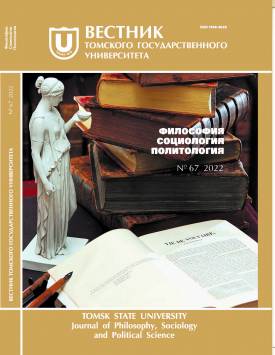Cooperation between Iran and the EAEU: Opportunities and constraints
The aim of this article is to identify various factors affecting cooperation between Iran and the Eurasian Economic Union (EAEU), and to determine the prospects for further cooperation. On May 17, 2018, an interim agreement was signed between the EAEU and Iran, leading to the formation of a free trade zone. Cooperation between Iran and the EAEU is developing in three main areas: trade, transport, and energy. The distribution of trade turnover between the EAEU countries and Iran is very uneven, a significant share in it belongs to Russia, and the smallest to Belarus and Kyrgyzstan. Transport projects and energy contracts can become a vector for the development of integration processes between Iran and the EAEU. The development of Iran’s relations with the EAEU and China opens up opportunities for connecting the transport corridors of the EAEU to the Chinese One Belt and One Road initiative in the southern direction. It seems possible to divide the process of economic rapprochement between the EAEU and Iran into three stages. The first stage of interaction is characterized by the study of the possibility of creating a free trade zone (FTZ) and identifying the benefits that both parties will receive from signing this agreement. The second stage will require the normative and legal consolidation of the norms and principles of trade and economic cooperation, and the signing of an interim agreement on the establishment of a FTZ. The third stage includes the development of a further action plan and negotiations to conclude a full-fledged agreement on the establishment of a FTZ. In the process of interaction with the EAEU, Iran may face certain problems. Restoration of the US sanctions in 2018, especially on the energy, shipping and financial sectors, has led to a decline in foreign investment and a blow to oil exports. The possibility of termination or suspension of foreign investment in transport projects can significantly affect Iran-EAEU cooperation. By creating and improving the transport and logistics infrastructure, Iran will become a link in the construction of international transport corridors. Further deepening of Iran-EAEU relations, however, will assist both parties to confront regional challenges and threats and to strengthen their security system in the region by establishing a dialogue with neighboring countries. The author declares no conflicts of interests.
Keywords
regional integration,
cooperation,
Eurasian Economic Union,
Iran,
Russia,
free trade zoneAuthors
| Zeleneva Irina V. | Saint Petersburg State University | irina_zeleneva@mail.ru |
Всего: 1
References
Saraswat D. Iran's Look to the East Policy 2.0: Reconciling Foreign Policy Independence and Economic Integration // Indian Council of World Affairs. 30 October 2018. URL: https://www.icwa.in/show_content.php?lang=1&level=3&ls_id=4823&lid=2826 (accessed: 18.10.2021).
The 20-Year National Vision of the Islamic Republic of Iran for the dawn of the Solar Calendar Year 1404 [2025 C.E.] // Iran Data Portal. URL: https://irandataportal.syr.edu/20-year-national-vision (accessed: 30.03.21).
Interim Agreement leading to formation of a free trade area between the Eurasian Economic Union and its Member States, of the one part, and the Islamic Republic of Iran, of the other part. May 17, 2018. URL: http://www.eurasiancommission.org/ru/act/trade/dotp/sogl_torg/Documents/Interim%20Agreement%20EAEU-Iran_final.pdf (accessed: 22.02.2021).
Memorandum between Business Council of the Eurasian Economic Union and the Iran Chamber of URL:Commerce, Industries, Mines and Agriculture. September 25, 2019. URL: http://www.eurasiancommission.org/ru/act/trade/dotp/sogl_torg/Documents/%d0%98%d1%80%d0%b0%d0%bd/%d0%9c%d0%b5%d0%bc%d0%be%d1%80%d0%b0%d0%bd%d0%b4%d1%83%d0%bc%20%d0%b0%d0%bd%d0%b3.pdf (accessed: 22.02.2021).
Внешняя торговля ЕАЭС по странам за 2019-2020 гг. // Евразийская экономическая комиссия. URL: http://www.eurasiancommission.org/ru/act/integr_i_makroec/dep_stat/tradestat/tables/extra/Documents/2020/12/E202012_2_1.pdf (дата обращения: 05.04.2021).
Товарооборот Ирана и ЕАЭС достиг двух миллиардов долларов // URL: https://www.iran.ru/news/economics/118855/Tovarooborot_Irana_i_EAES_dostig_dvuh_milliardov_dollarov?utm_source=yxnews&utm_medium=desktop (дата обращения: 22.02.2021)
Smagin Л/EAEU - Iran Trade and Its Prospects. April 6, 2021. URL: https://russiancouncil.ru/en/analytics-and-comments/analytics/eaeu-iran-trade-and-its-prospects/(accessed: 24.10.21).
Евразийские транспортные коридоры: текущий статус и перспективы // Всероссийская академия внешней торговли. 2019. URL: https://www.vavt-imef.ru/wp-content/uploads/2019/11/% D0%94%D0%BE%D0%BA%D0%BB%D0%B0%D0%B4-%D0%92%D0%90%D0%92%D0% A2-% D0%A6% D0%AD%D0%98.pdf (дата обращения: 05.04.2021).
Индия не готова подписать меморандум по газопроводу из-за Пакистана // РИА Новости. 15.01.2020. URL: https://ria.ru/20200115/1563432843.html (дата обращения: 05.04.2021).
COUNCIL REGULATION (EU) No 267/2012 of 23 March 2012 concerning restrictive measures against Iran and repealing Regulation (EU) No 961/2010 // Official Journal of the European Union. URL: https://eur-lex.europa.eu/LexUriServ/LexUriServ.do?uri=0J:L:2012:088:0001:0112:EN:PDF (accessed: 13.04.2021).
Micovic N. Iran wants to join the Eurasian Economic Union - but will Russia allow it? // ArabNews. February 26, 2021. URL: https://www.arabnews.com/node/1816451 (accessed: 10.04.2021).
Lim K. Iran’s Eurasia Wager // The Washington Institute for Near East Policy. April 20, 2020. URL: https://www.washingtoninstitute.org/policy-analysis/irans-eurasian-wager (accessed: 10.04.2021).
Vatanka A.Russia, Iran and economic integration on the Caspian // Middle East Institute. August 17, 2020. URL: https://www.mei.edu/publications/russia-iran-and-economic-integrationcaspian (accessed: 11.04.2021).
Kumar M., Verma N. India likely to start full operations at Iran's Chabahar port by May end // Reuters. March, 2021. URL: https://www.reuters.com/article/india-iran-ports-int-idUSKBN2AX1DK (accessed: 11.04.2021).
Расулинежад Э., Орлова О.Г. Торгово-экономическая интеграция Евразийского экономического союза и Исламской Республики Иран как направление международной деятельности ЕАЭС // Московский экономический журнал. 2020. № 10. С. 189. doi 10.24411/2413-046Х-2020-10699
Иран рассчитывает на продолжение регионального сотрудничества с Россией // ТАСС. 9 февраля 2021. URL: https://tass.ru/mezhdunarodnaya-panorama/10660745 (дата обращения: 12.04.2021).
Барари Х., Зеленева И.В. Возможности российско-иранского сотрудничества в энергетической сфере // Вестник Забайкальского государственного университета. 2020. № 10. С. 2835. doi: 10.21209/2227-9245-2020-26-10-28-35
Azizi H. Iran and the Eurasian Transport Initiatives: Short-term Challenges, Long-term Opportunities // The Institute for Iran-Eurasia Studies. February 21, 2019. URL: http://iraneurasia.ir/en/doc/article/ 3812/ iran-and-the-eurasian-transport-initiatives-short-term-challen-ges-long-opportunities (accessed: 18.10.2021).

